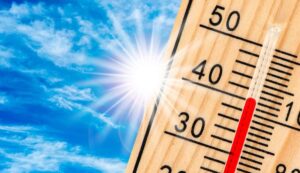A heat wave is a period of time when the weather is excessively hot for an extended period. It is generally defined as three or more days with temperatures higher than what is considered normal for that time of year. Heat waves can be dangerous, especially for people who are elderly, young, or have ongoing health problems.
The specific temperature threshold for a heat wave varies depending on the location. In the United States, the National Weather Service defines a heat wave as three or more days with temperatures at least 90 degrees Fahrenheit (32 degrees Celsius) in the lower 48 states. Other countries may have different thresholds.
For example, in the Northeastern United States, a heat wave is typically defined as three consecutive days where the temperature reaches or exceeds 90 degrees Fahrenheit (32 degrees Celsius), but it may also consider humidity levels to determine a heat index threshold. In California, a heat wave is defined as five consecutive days at or above 95 degrees Fahrenheit (35 degrees Celsius), or three consecutive days at or above 100 degrees Fahrenheit (38 degrees Celsius).

Heat waves can have serious effects, especially on vulnerable populations such as the elderly, young children, and those with chronic health conditions. They can lead to heat stroke, heat exhaustion, and other heat-related illnesses. Heat waves also increase the risk of heart attacks, strokes, and other health problems.
To stay safe during the waves of heat, there are several things you can do:
- Stay hydrated by drinking plenty of fluids, even if you don’t feel thirsty.
- Stay indoors in cool places with air conditioning as much as possible.
- Avoid strenuous activities and try to rest in shaded or air-conditioned areas.
- Wear loose-fitting, light-colored clothing and a hat if you need to go outside.
- Take cool showers or baths to help lower your body temperature.
- Check on elderly neighbors or relatives to make sure they are okay.
If you experience symptoms of heat stroke or heat exhaustion, it’s crucial to seek medical attention immediately. Symptoms of heat stroke include a high body temperature (above 103 degrees Fahrenheit), hot and dry skin, rapid breathing, and confusion. Symptoms of heat exhaustion include a lower body temperature (above 99 degrees Fahrenheit), cool and clammy skin, and fatigue.
Heat waves can be caused by various factors, including:
- Warm air masses move from the tropics to other regions, bringing hot weather.
- Lack of precipitation, which leads to dry ground that heats up quickly.
- High-pressure systems trap hot air in an area, resulting in prolonged hot weather.
Heat waves can have several negative effects, such as:
- Heatstroke, which is a life-threatening condition caused by excessively high body temperature.
- Heat exhaustion, which occurs when the body loses too much water and salt.
- Increased risk of fires due to hot and dry conditions.
- Increased risk of respiratory problems because hot and dry air can irritate the lungs.
Remember to stay informed about weather conditions during a heat wave and take necessary precautions to stay safe.
What Temperature Is Considered a Heat Wave?
A heat wave is a period of exceptionally hot weather that lasts for several days. The definition of a heat wave can vary depending on where you are. In the United States, a heat wave is generally considered to occur when the temperature reaches or goes above 90 degrees Fahrenheit (32.2 degrees Celsius) for three or more consecutive days. However, in certain regions, like the Northeast, the temperature threshold may be lower, around 80 degrees Fahrenheit (26.7 degrees Celsius).
When determining a heat wave, it’s not just about the temperature; humidity is also taken into account. Humidity refers to the amount of moisture in the air. When the humidity is high, the heat index, which measures how hot it feels, can be much higher than the actual temperature. For example, if the temperature is 90 degrees Fahrenheit and the humidity is 70%, the heat index can make it feel as hot as 105 degrees Fahrenheit.
Heat waves can pose a risk to people’s health, particularly for certain groups. Young children, elderly individuals, and people with chronic health conditions are more vulnerable to the dangers of extreme heat. Heat-related illnesses can occur during a heat wave and include symptoms such as heat cramps, heat exhaustion, and heat stroke. If you experience any of these symptoms, it is crucial to seek medical attention immediately.
Impacts of Heat Wave Temperatures
Heat waves are prolonged periods of excessively hot weather that can have significant impacts on people and the environment. Here are some important points to know about heat waves:
Heat waves are becoming more common: Over the past few decades, the number of heat waves has increased by about 50%. This rise in frequency is mainly attributed to climate change, which is causing the Earth’s atmosphere to warm up.
Certain groups are more vulnerable: Heat waves can be particularly dangerous for certain groups of people. The elderly, young children and individuals with pre-existing health conditions are more susceptible to the health risks associated with extreme heat. They are also at a higher risk of suffering from heat-related illnesses and even death.
Heat waves affect the economy: Heat waves can have far-reaching economic consequences. During extreme heat, there may be a decrease in productivity as people struggle to work in uncomfortable conditions. Additionally, the healthcare system may experience increased costs due to the treatment of heat-related illnesses. Infrastructure, such as roads and power grids, can also suffer damage from heat stress.
Reducing the risk of heat-related illnesses: There are several measures that individuals can take to lower the risk of heat-related illnesses during a heat wave. These include staying hydrated by drinking plenty of water, seeking shelter in air-conditioned or cool indoor spaces, and avoiding strenuous physical activities during the hottest parts of the day.
In addition to the above information, here are some extra tips for staying safe and comfortable during a heat wave:
Avoid alcohol and caffeine: These substances can contribute to dehydration, so it’s best to limit or avoid them during hot weather.
Take cool baths or showers: Cooling down your body with a refreshing bath or shower can help lower your body temperature and provide temporary relief from the heat.

Use fans or air conditioners: Fans and air conditioners can circulate air and provide cooling comfort in indoor spaces. If possible, use these cooling devices to maintain a comfortable temperature.
Protect yourself from the sun: Wearing a hat and sunglasses can shield you from the sun’s intense rays and help prevent sunburn. Additionally, applying sunscreen with a high SPF can protect your skin from sun damage.
Check on vulnerable individuals: Keep an eye on elderly neighbors and relatives, as they may require assistance during a heat wave. Make sure they have access to cool places, encourage them to stay hydrated, and offer support as needed.
Recognize heat-related illnesses: It’s crucial to be aware of the signs and symptoms of heat stroke and heat exhaustion. Heat stroke is a severe condition that requires immediate medical attention and can include a high body temperature, hot and dry skin, rapid breathing, and confusion. Heat exhaustion is milder but still serious, with symptoms such as a slightly elevated body temperature, cool and clammy skin, fatigue, and dizziness.
For More Safety Tips – Click Here
By taking necessary precautions, staying well-informed about the weather, and looking out for one another, individuals can stay safe and minimize the risks associated with heat waves.
Texas Heat Wave Weather Forecast of July 2023 – Click Here
Source: The Internet

I don’t think the title of your article matches the content lol. Just kidding, mainly because I had some doubts after reading the article.
Thanks for sharing. I read many of your blog posts, cool, your blog is very good. https://accounts.binance.info/en-IN/register-person?ref=UM6SMJM3
Thanks for sharing. I read many of your blog posts, cool, your blog is very good.
ee88 app là ứng dụng cá cược trực tuyến hiện đại, giúp người chơi dễ dàng tham gia mọi lúc, mọi nơi với giao diện tối ưu trên điện thoại.
Leo88 là sân chơi lý tưởng cho cộng đồng đam mê tựa game bài đổi thưởng, với hệ thống bảo mật tối cao và giao diện thân thiện.
33win là nhà cái cá cược hàng đầu hiện nay, tại đây mang đến kho trò chơi phong phú, từ thể thao, casino trực tuyến đến game bài đổi thưởng.